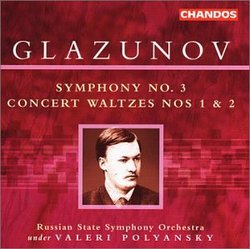| All Artists: Glazunov, Polyansky, Russian State So Title: Symphony 3 / Concert Waltz 1 & 2 Members Wishing: 0 Total Copies: 0 Label: Chandos Release Date: 4/23/2002 Genre: Classical Style: Symphonies Number of Discs: 1 SwapaCD Credits: 1 UPC: 095115965825 |
Search - Glazunov, Polyansky, Russian State So :: Symphony 3 / Concert Waltz 1 & 2
 | Glazunov, Polyansky, Russian State So Symphony 3 / Concert Waltz 1 & 2 Genre: Classical
|
Larger Image |
CD Details |
CD ReviewsThe best performance of Glazunov's third symphony 05/29/2002 (5 out of 5 stars) "Polyansky and the Russian State Symphony Orchestra shed a new light on innovative polyphony organized by Glazunov in his third symphony. Polyansky's performance tells us most persuasively the whole stories implied in this symphony. As for the lovely folk song (by flute) heard in the middle of the second movement, which has been the most favorite passage to me, we feel as if all the members in the wind section would act as people living in an old village somewhere in our country. The most impressive to me was his performance of the third movement, which I suppose describes how young composer had worked out his seminal inspirations into innovative structures. Polyansky tells us how the third movement constitutes the core notion implied in this symphony. Thus, I suppose, Polyansky's performance shows us most successfully how the third symphony represents one of the most important masterpieces in Glazunov's whole life as a symphony-composer of the new era." Glazunov's Third - Gladsome and Glorious G. Charles Steiner | San Francisco | 12/04/2007 (5 out of 5 stars) "Thare are three pieces of music offered on this CD: The Third Symphony as well as two Waltz Concertos. I bought this album solely for the Third Symphony (to complete my collection of all 8 of Glazunov's symphonies).
There are four movements to Glazunov's Third Symphony; they are Allegro, Vivace, Andante, and Allegro Moderato. It's impossible not to like the Allegro movement with its full, rich, expanding, colorful harmonies. Its happy, joyous energy and harmony is addictive. The Vivace second movement is playful and abstract yet full of subtle harmonies. I liken the Andante third movement to Wagner's Tannhauser overtures, only lighter; I can liken it also to Mozart's later symphonies (say, the Jupiter Symphony) because although harmonious and colorful (Glazunov is never modernist), it has a few, specially selected, dark touches and dark flourishes to make the music seductive and contrasting. The fourth Allegro moderato movement is adventurous as the Queen's ships returning from a successful sea voyage conquering renegade pirates full of the Queen's stolen treasures, and concludes satisfyingly in only that way that is Glazunov's unique and personal musical stamp. Of the two waltz concertos ending the album, the second waltz concerto is the better of the two because of its originality. The first feels like a copy of a Richard Strauss's work merely. It's pleasant to listen to, but imitative. The Third Symphony, as a penetrating musical experience, has that astonishing quality of being over and done with sooner than you can ever want. The music quickly passes time over as if under a spell." |

 Track Listings (6) - Disc #1
Track Listings (6) - Disc #1